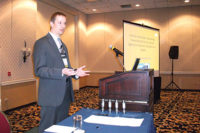Those topics are just some of what comprised technical talk at the most recent Ammonia Refrigeration Conference & Trade Show of the International Institute of Ammonia Refrigeration. Topics turned up in workshops, panel discussions, and technical paper presentations.
THE CO2 ISSUE
The use of carbon dioxide as a natural refrigerant was the topic of two workshops.Presenters pointed out that use of CO2 in a cascade system reduces the amount of ammonia needed at a site and that, like ammonia, CO2 is also a comparatively inexpensive and efficient refrigerant. They did warn of having to deal with higher pressures of CO2 and some other cautions in working with the refrigerant, just as there are, they said, cautions and cares needed with ammonia.
But, “CO2 is coming and it is a viable alternative. More people are going to use it,” said Charles Taylor of the Stellar Group, a contractor experienced with using CO2.
Presenters said that at the time of the conference there were 196 CO2/ammonia cascade systems in Europe, and eight in the United States.

Participating in a panel on CO2 as a refrigerant are, from left, Charles Taylor of the Stellar Group, Andy Pearson of Star Refrigeration, Ronald Worley of Nestlé USA, and Ole Christensen and Greg Robison, both of M&M Refrigeration.
Click on the picture to see an enlarged version of it.
Click on the picture to see an enlarged version of it.
PAPERS
The issue of improving efficiencies was covered in a paper presented by Marcus Wilcox and Robert Morton of Cascade Engineering. They suggested using a “Kaizen Blitz” approach to solve problems. They called it “a quick and intensive” way to eliminate waste, improve productivity, and achieve continuous improvement in targeted activities. “Low-risk changes are made on the spot and documented,” they said. “Other changes are phased in so that the system response can be observed over a period of days or weeks.”Inspecting systems for mechanical integrity was the topic of the paper by Jim Kovarik of Lixi Inc. “Nondestructive inspection is an essential tool for maintaining mechanical integrity,” he said. “Before engaging a contractor in this field, make sure you are sufficiently knowledgeable about all the elements. “Be resourceful in your approach to finding a qualified contractor, using your own mechanical contractor as the beginning of your networking.”
In a paper on microprocessor controls, James Conant and Michael Ghan of Logix Refrigeration Controls noted how the technology is now able to take better advantage of its data processing power. They called for a ‘whole system’ approach “looking at all the variables in the plant and how they interact. That is what distinguishes today’s controls technology from less capable systems of the past.”
Dealing with stress corrosion cracking (SCC) was discussed by Rowe Bansch of Refrigeration Valves & Systems Corp. He noted that such problems “are very rare in pressure vessels in the ammonia refrigeration business, but are occasionally found. “Simple precautions in the specification and design of pressure vessels can reduce the risk of SCC-related failures. If a vessel has been in service for more than 18 months, then it is very unlikely to develop a stress corrosion cracking leak.”
Airflow in especially large refrigerated warehouses was discussed by Heinz Jackmann of Hans Guntner GmbH. He explained that a ductless design that uses what he called a reverse airflow pattern with downward airflow against the wall and into the floor. “Velocities were minimized to prevent room turbulence and allow natural air convection and diffusion.”
In another paper dealing with larger warehouses, Jeremy Klysen and David J. Ross of the Leo A. Daly architectural firm, talked about “today’s refrigerated warehouses that are growing up instead of out due to new warehouse technologies and for economic reasons.” To deal with that, the speakers suggested the use of “controlled pressure receiver overfeed systems coupled with modern controls.” This approach, they said, “has superior features which enhance the ability to properly feed liquid to evaporators.”
Troubleshooting of ammonia systems that use plate heat exchangers (PHEs) was the topic of Mats A.T. Stromblad of Alfa Laval AB. “Generally adequate solutions to troubleshooting problems have been developed and they (the problems) appear more rarely today as PHE technology becomes more refined.” He also said “there are ways facility managers can solve a number of general types of problems using PHEs, which can be adapted to a majority of the many demanding cooling and freezing applications in ammonia refrigeration.”
To minimize unit-freezing costs, Stefan Jensen of Scantec Refrigeration Technologies and Marion Lehman of IBEX Technologies described a new methodology. “The methodology estimates evaporator performance and product freezing time ... and determines the equilibrium between cooling load and evaporator capacity. Sensitivity analyses show the influence of evaporating temperature, product temperatures, air velocity, evaporator fouling, and product packaging on freezer performance.”
In a paper on thermal analyses of food freezing, John Masson of the Stahlman Group said, “The key to designing effective food freezing processes is to understand correctly what actually happens when a nonhomogeneous item is cooled from its initial freeze point to the final process temperature.
“Using computer-based numerical techniques, consulting engineers can provide value to clients. By understanding the variability in food properties, end users and equipment designers can work together to design better food freezing processes with more predictable outcomes.”
Publication date:05/14/2007





